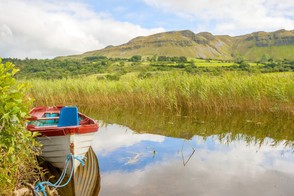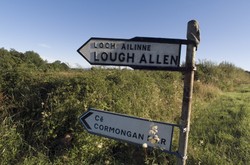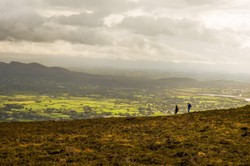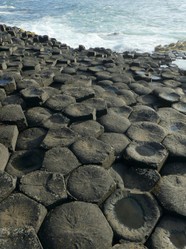County Cavan, a lowland county, projects North West into more hilly territory, a strip that runs along the border with Northern Ireland. Much of the border along this stretch runs through a pair of loughs, Upper and Lower Lough MacNean. Almost all of the lower lough is in the North, but the Upper Lough is evenly divided, and it contains some islands on its eight mile stretch. The isthmus between the two lakes contains a few drumlins, and these glacial features characterize the landscape in the region.
The road that runs south of the Upper Lough heads for Sligo twenty six miles away, and the theological college where I studied for a while [now closed and used for a succession of different purposes] stood by a broad headland projecting into the Upper Lough.Though in Cavan, we were but a hundred metres from County Leitrim, and my walking took me often into that county.
Having come from a theological college in London, under the flight path for Heathrow Airport and near the Great West Road I had been starved of silence by the incessant rumblings of planes and traffic throughout the day and night. In North West Ireland I got silence in abundance. I would stroll down to the lough, sit by its gently wavy waters and think, with my eyes scanning over the islands to the low, green and soft hills of County Fermanagh.
The view south of the college was delightful. The bulk of Cuilcagh, through whose misty, peat-covered summit the border with Northern Ireland ran along an ill-defined route, stood powerfully. There were few dwellings on that mountain, and at night only occasional specks of light freckled its darkened slopes. There was also the Glenfarne Plateau, named from the village at its foot, lower than Cuilcagh and not technically a mountain, being but fourteen hundred feet, it was wild land on which few trod for any but necessity: a truly lonely place with few paths to its peaty summit.
But besides panorama, the small sights matter. As Autumn fell on the land the hedges were spangled with spiders' webs. Webs of the veil web spider, they are constructed around plant stems and form a pyramid that sometimes appears diamond shaped. The hedges were full of them, and the dew glistened in myriad crystal droplets along their skeins. Thinking of Scripture, one reflects "Not even Solomon in his glory was arrayed as one of these." In September the hedges held blackthorn berries: they look nice, but they dry your mouth to the point that you feel you have been chewing sandpaper.











 Women of the Gospelson 10/11/2025
Women of the Gospelson 10/11/2025
 Religious Gardenson 08/25/2025
Religious Gardenson 08/25/2025
 Doctor of the Church: John Henry Newmanon 08/03/2025
Doctor of the Church: John Henry Newmanon 08/03/2025
 Restoring the Palm Houseon 07/16/2025
Restoring the Palm Houseon 07/16/2025



Comments
I think that there is a rite of deconsecration.
Thank you!
Does the deconsecration just involve a changed status in Church record-keeping or does it mandate something ceremonial or ritual?
If a church building is no longer usedbforbreligious purposes it is automatically deconscrated.
The second paragraph to the first subheading, The Experience of North West Ireland, describes the theological college where you studied as "now closed and used for a succession of different purposes."
Do the various purposes fit among Church pursuits?
If not, does the college get deconsecrated?
(There's a church that subsequently operated as an Italian restaurant in downtown Salt Lake City, about halfway between the Cathedral of the Madeleine and the public library. It needed to be deconsecrated for the purpose to be modified from sacred to mundane.)
Yes, Absolutely, right.
Thank you!
May we say "chalky" is synonymous with "chalk-like" or "near-chalky"?
The bedrock of the mountain is limestone, which is chemically close to chalk.
The English Wikipedia designates as Cuilcagh origins the Irish word cuilceach, for "chalky."
That same article describes the "chalky peak" as actually of bog- and heather-covered sandstone and shale.
Is it known why the afore-mentioned adjective acts as moniker for Binn Chuilceach ("chalky peak")?
I was thinking of quietness in terms of human activity. I walked the route in day time, but it is very dark at night, so I had no experience of it at night.
Your introduction alerts us to the fact that "The road from the lowlands of Cavan to Sligo passes through a quiet area of borderland" and that "Just past this lough [Lough MacNean] a road turns downwards towards Lough Allen, and this is one of the quietest routes that I have walked on."
Does quiet hold for the day as well as for the night?
A patch quiet here during the day well may have crickets or frogs and toads or nightjars and warblers during the evening and the night.